tire type INFINITI QX50 2020 Owner's Manual
[x] Cancel search | Manufacturer: INFINITI, Model Year: 2020, Model line: QX50, Model: INFINITI QX50 2020Pages: 580, PDF Size: 7.43 MB
Page 47 of 580

SMALL CHILDREN
Children that are over 1 year old and weigh at
least 20 lbs. (9 kg) should remain in a rear-
facing child restraint as long as possible up to
the height or weight limit of the child re-
straint. Children who outgrow the height or
weight limit of the rear-facing child restraint
and are at least 1 year old should be secured
in a forward-facing child restraint with a har-
ness. Refer to the manufacturer’s instructions
for minimum and maximum weight and
height recommendations. INFINITI recom-
mends that small children be placed in child
restraints that comply with Federal Motor
Vehicle Safety Standards or Canadian Motor
Vehicle Safety Standards. You should choose
a child restraint that fits your vehicle and
always follow the manufacturer’s instruc-
tions for installation and use.
LARGER CHILDREN
Children should remain in a forward-facing
child restraint with a harness until they reach
the maximum height or weight limit allowed
by the child restraint manufacturer.Once a child outgrows the height or weight
limit of the harness-equipped forward-facing
child restraint, INFINITI recommends that
the child be placed in a commercially available
booster seat to obtain proper seat belt fit. For
a seat belt to fit properly, the booster seat
should raise the child so that the shoulder belt
is properly positioned across the chest and
the top, middle portion of the shoulder. The
shoulder belt should not cross the neck or
face and should not fall off the shoulder. The
lap belt should lie snugly across the lower hips
or upper thighs, not the abdomen. A booster
seat can only be used in seating positions that
have a three-point type seat belt. The
booster seat should fit the vehicle seat and
have a label certifying that it complies with
Federal Motor Vehicle Safety Standards or
Canadian Motor Vehicle Safety Standards.
A booster seat should be used until the child
can pass the seat belt fit test below:
∙ Are the child’s back and hips against the vehicle seatback?
∙ Is the child able to sit without slouching?
∙ Do the child’s knees bend easily over the front edge of the seat with feet flat on
the floor? ∙ Can the child safely wear the seat belt
(lap belt low and snug across the hips and
shoulder belt across mid-chest and
shoulder)?
∙ Is the child able to use the properly ad- justed head restraint/headrest?
∙ Will the child be able to stay in position for the entire ride?
Safety—Seats, seat belts and supplemental restraint system1-21
Page 121 of 580
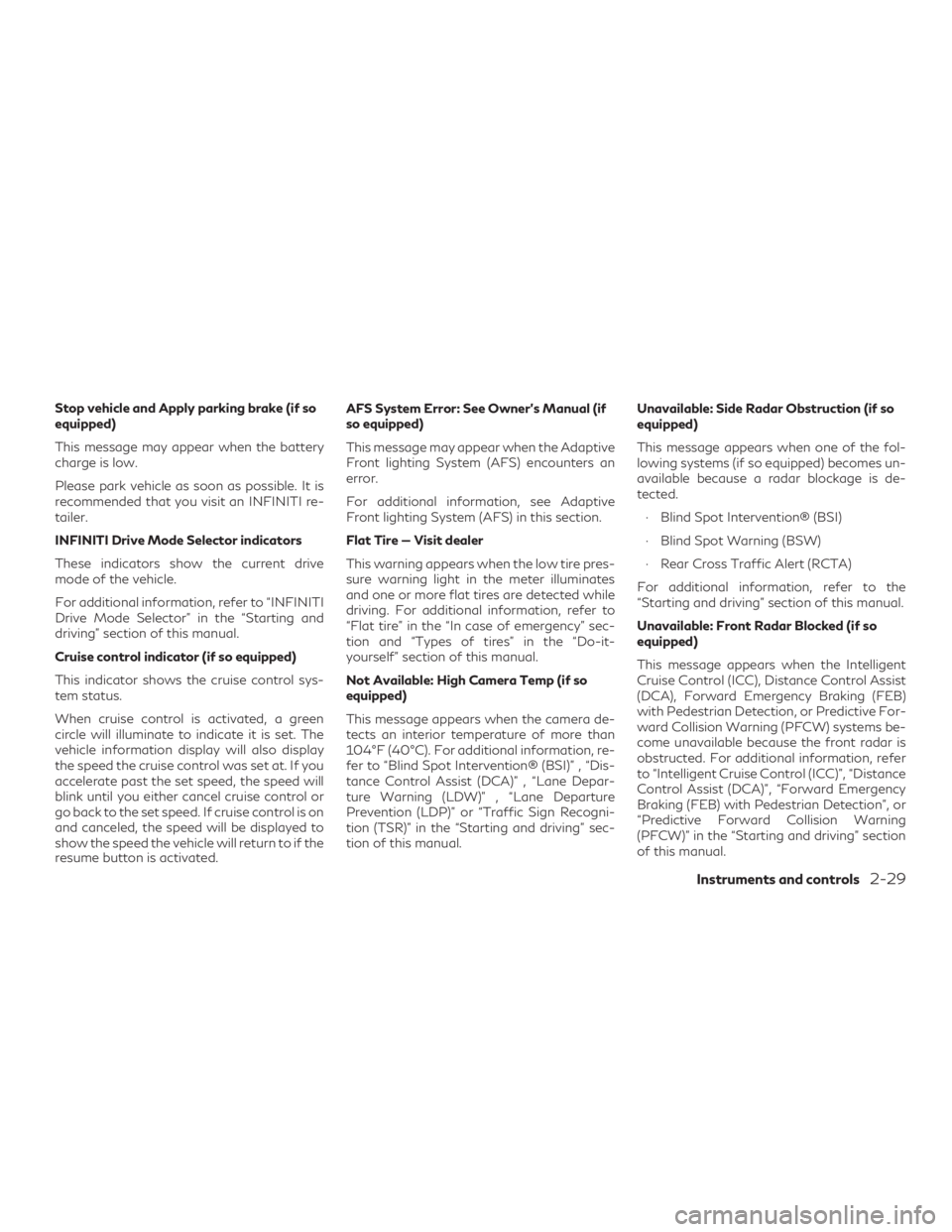
Stop vehicle and Apply parking brake (if so
equipped)
This message may appear when the battery
charge is low.
Please park vehicle as soon as possible. It is
recommended that you visit an INFINITI re-
tailer.
INFINITI Drive Mode Selector indicators
These indicators show the current drive
mode of the vehicle.
For additional information, refer to “INFINITI
Drive Mode Selector” in the “Starting and
driving” section of this manual.
Cruise control indicator (if so equipped)
This indicator shows the cruise control sys-
tem status.
When cruise control is activated, a green
circle will illuminate to indicate it is set. The
vehicle information display will also display
the speed the cruise control was set at. If you
accelerate past the set speed, the speed will
blink until you either cancel cruise control or
go back to the set speed. If cruise control is on
and canceled, the speed will be displayed to
show the speed the vehicle will return to if the
resume button is activated.AFS System Error: See Owner’s Manual (if
so equipped)
This message may appear when the Adaptive
Front lighting System (AFS) encounters an
error.
For additional information, see Adaptive
Front lighting System (AFS) in this section.
Flat Tire — Visit dealer
This warning appears when the low tire pres-
sure warning light in the meter illuminates
and one or more flat tires are detected while
driving. For additional information, refer to
“Flat tire” in the “In case of emergency” sec-
tion and “Types of tires” in the “Do-it-
yourself” section of this manual.
Not Available: High Camera Temp (if so
equipped)
This message appears when the camera de-
tects an interior temperature of more than
104°F (40°C). For additional information, re-
fer to “Blind Spot Intervention® (BSI)” , “Dis-
tance Control Assist (DCA)” , “Lane Depar-
ture Warning (LDW)” , “Lane Departure
Prevention (LDP)” or “Traffic Sign Recogni-
tion (TSR)” in the “Starting and driving” sec-
tion of this manual.
Unavailable: Side Radar Obstruction (if so
equipped)
This message appears when one of the fol-
lowing systems (if so equipped) becomes un-
available because a radar blockage is de-
tected.
∙ Blind Spot Intervention® (BSI)
∙ Blind Spot Warning (BSW)
∙ Rear Cross Traffic Alert (RCTA)
For additional information, refer to the
“Starting and driving” section of this manual.
Unavailable: Front Radar Blocked (if so
equipped)
This message appears when the Intelligent
Cruise Control (ICC), Distance Control Assist
(DCA), Forward Emergency Braking (FEB)
with Pedestrian Detection, or Predictive For-
ward Collision Warning (PFCW) systems be-
come unavailable because the front radar is
obstructed. For additional information, refer
to “Intelligent Cruise Control (ICC)”, “Distance
Control Assist (DCA)”, “Forward Emergency
Braking (FEB) with Pedestrian Detection”, or
“Predictive Forward Collision Warning
(PFCW)” in the “Starting and driving” section
of this manual.
Instruments and controls2-29
Page 265 of 580
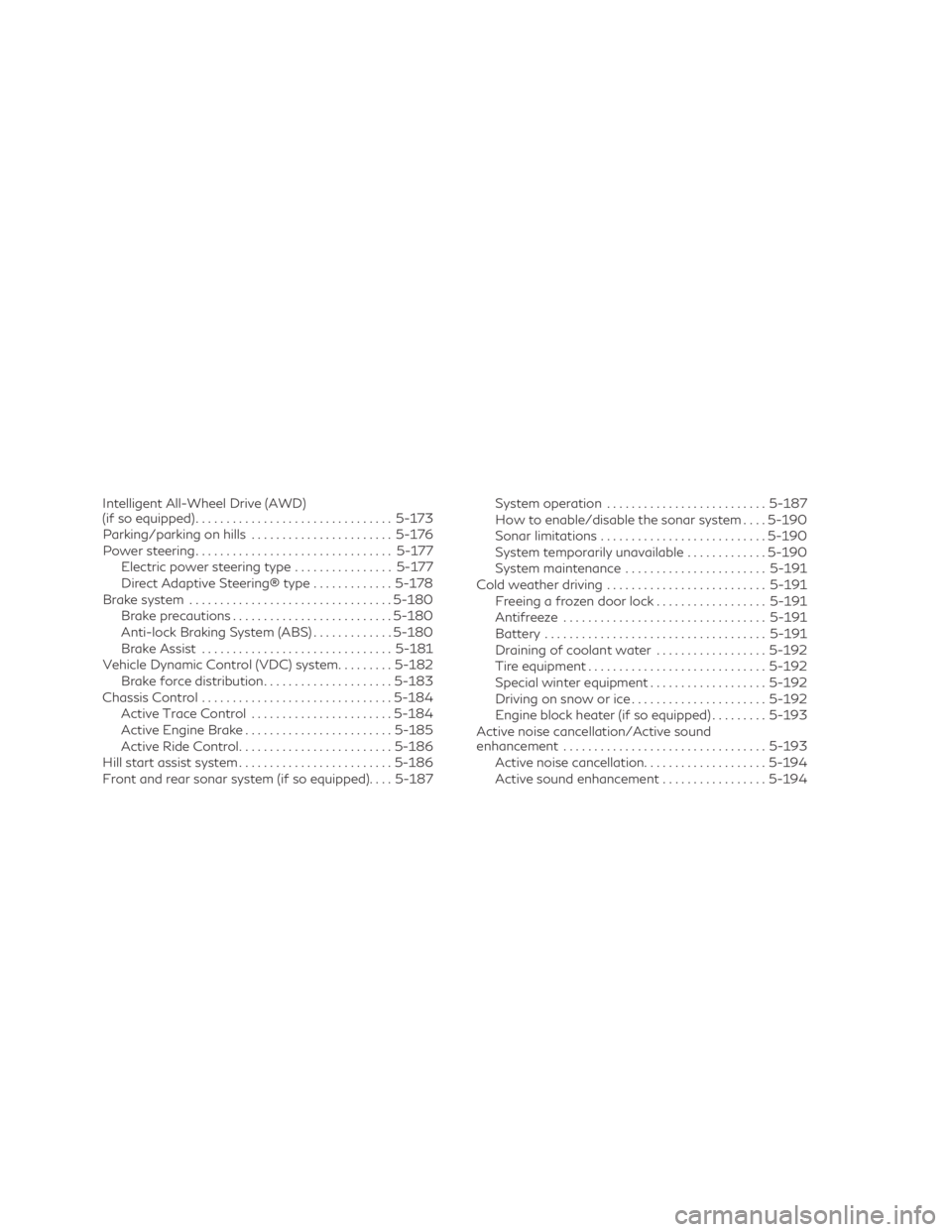
Intelligent All-Wheel Drive (AWD)
(if so equipped)................................ 5-173
Parking/parking on hills .......................5-176
Power steering ................................ 5-177
Electric power steering type ................5-177
Direct Adaptive Steering® type .............5-178
Brake system ................................. 5-180
Brake precautions .......................... 5-180
Anti-lock Braking System (ABS) .............5-180
Brake Assist ............................... 5-181
Vehicle Dynamic Control (VDC) system .........5-182
Brake force distribution .....................5-183
Chassis Control ............................... 5-184
Active Trace Control ....................... 5-184
Active Engine Brake ........................ 5-185
Active Ride Control ......................... 5-186
Hill start assist system ......................... 5-186
Front and rear sonar system (if so equipped) ....5-187 System operation
.......................... 5-187
How to enable/disable the sonar system ....5-190
Sonar limitations ........................... 5-190
System temporarily unavailable .............5-190
System maintenance ....................... 5-191
Cold weather driving .......................... 5-191
Freeing a frozen door lock ..................5-191
Antifreeze ................................. 5-191
Battery .................................... 5-191
Draining of coolant water ..................5-192
Tire equipment ............................. 5-192
Special winter equipment ...................5-192
Driving on snow or ice ...................... 5-192
Engine block heater (if so equipped) .........5-193
Active noise cancellation/Active sound
enhancement ................................. 5-193
Active noise cancellation ....................5-194
Active sound enhancement .................5-194
Page 271 of 580
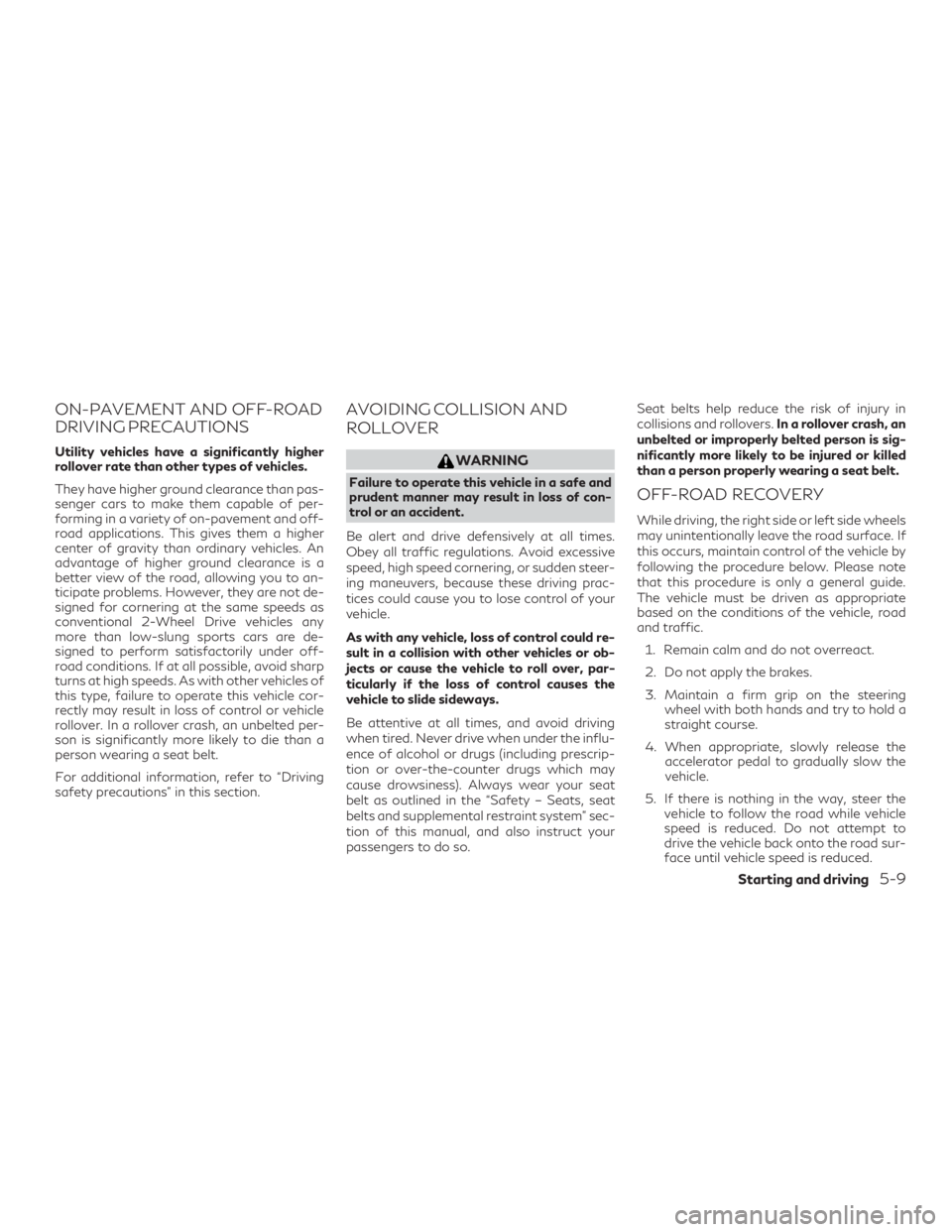
ON-PAVEMENT AND OFF-ROAD
DRIVING PRECAUTIONS
Utility vehicles have a significantly higher
rollover rate than other types of vehicles.
They have higher ground clearance than pas-
senger cars to make them capable of per-
forming in a variety of on-pavement and off-
road applications. This gives them a higher
center of gravity than ordinary vehicles. An
advantage of higher ground clearance is a
better view of the road, allowing you to an-
ticipate problems. However, they are not de-
signed for cornering at the same speeds as
conventional 2-Wheel Drive vehicles any
more than low-slung sports cars are de-
signed to perform satisfactorily under off-
road conditions. If at all possible, avoid sharp
turns at high speeds. As with other vehicles of
this type, failure to operate this vehicle cor-
rectly may result in loss of control or vehicle
rollover. In a rollover crash, an unbelted per-
son is significantly more likely to die than a
person wearing a seat belt.
For additional information, refer to “Driving
safety precautions” in this section.
AVOIDING COLLISION AND
ROLLOVER
WARNING
Failure to operate this vehicle in a safe and
prudent manner may result in loss of con-
trol or an accident.
Be alert and drive defensively at all times.
Obey all traffic regulations. Avoid excessive
speed, high speed cornering, or sudden steer-
ing maneuvers, because these driving prac-
tices could cause you to lose control of your
vehicle.
As with any vehicle, loss of control could re-
sult in a collision with other vehicles or ob-
jects or cause the vehicle to roll over, par-
ticularly if the loss of control causes the
vehicle to slide sideways.
Be attentive at all times, and avoid driving
when tired. Never drive when under the influ-
ence of alcohol or drugs (including prescrip-
tion or over-the-counter drugs which may
cause drowsiness). Always wear your seat
belt as outlined in the “Safety – Seats, seat
belts and supplemental restraint system” sec-
tion of this manual, and also instruct your
passengers to do so. Seat belts help reduce the risk of injury in
collisions and rollovers.
In a rollover crash, an
unbelted or improperly belted person is sig-
nificantly more likely to be injured or killed
than a person properly wearing a seat belt.OFF-ROAD RECOVERY
While driving, the right side or left side wheels
may unintentionally leave the road surface. If
this occurs, maintain control of the vehicle by
following the procedure below. Please note
that this procedure is only a general guide.
The vehicle must be driven as appropriate
based on the conditions of the vehicle, road
and traffic.
1. Remain calm and do not overreact.
2. Do not apply the brakes.
3. Maintain a firm grip on the steering wheel with both hands and try to hold a
straight course.
4. When appropriate, slowly release the accelerator pedal to gradually slow the
vehicle.
5. If there is nothing in the way, steer the vehicle to follow the road while vehicle
speed is reduced. Do not attempt to
drive the vehicle back onto the road sur-
face until vehicle speed is reduced.
Starting and driving5-9
Page 274 of 580
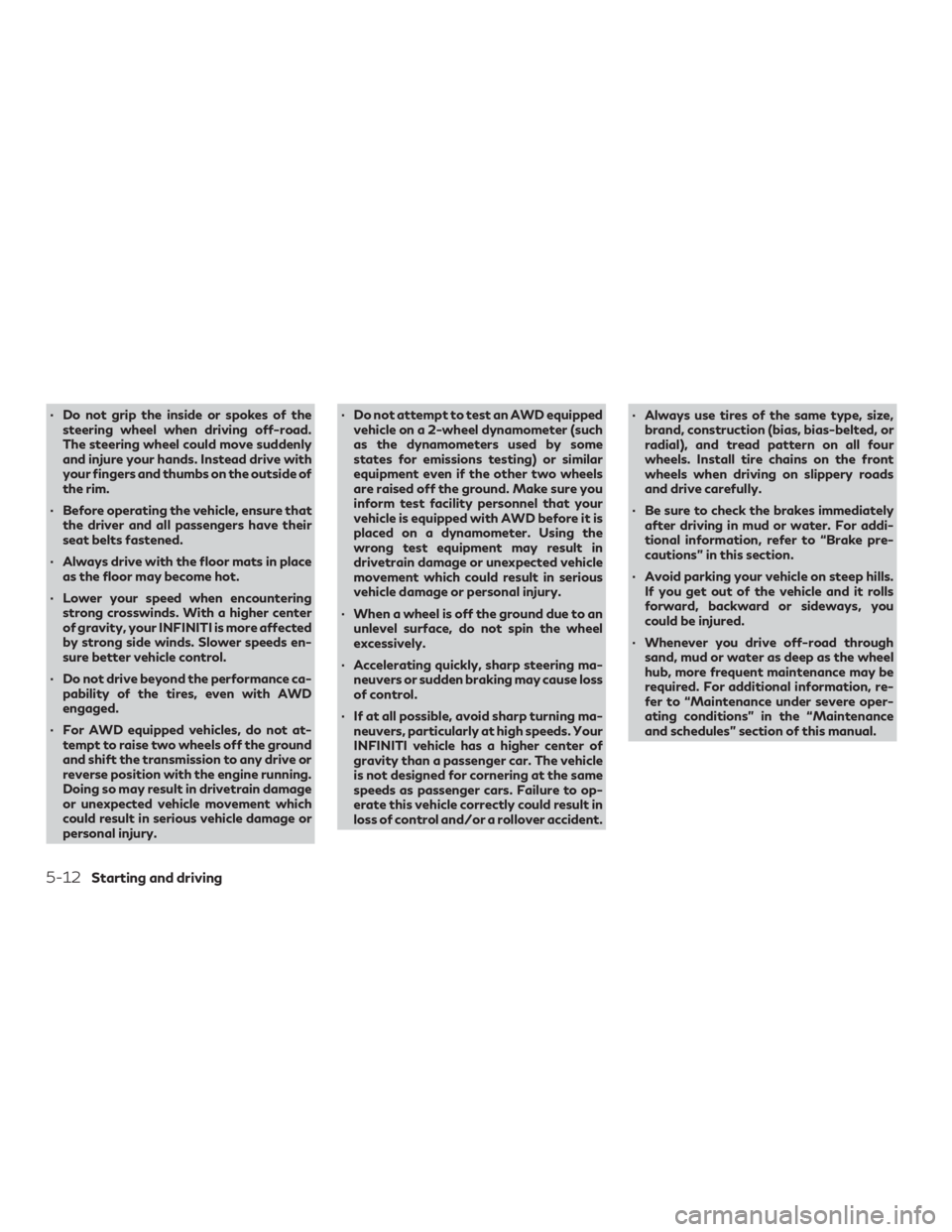
∙ Do not grip the inside or spokes of thesteering wheel when driving off-road.
The steering wheel could move suddenly
and injure your hands. Instead drive with
your fingers and thumbs on the outside of
the rim.
∙ Before operating the vehicle, ensure that the driver and all passengers have their
seat belts fastened.
∙ Always drive with the floor mats in place as the floor may become hot.
∙ Lower your speed when encountering strong crosswinds. With a higher center
of gravity, your INFINITI is more affected
by strong side winds. Slower speeds en-
sure better vehicle control.
∙ Do not drive beyond the performance ca- pability of the tires, even with AWD
engaged.
∙ For AWD equipped vehicles, do not at- tempt to raise two wheels off the ground
and shift the transmission to any drive or
reverse position with the engine running.
Doing so may result in drivetrain damage
or unexpected vehicle movement which
could result in serious vehicle damage or
personal injury. ∙ Do not attempt to test an AWD equipped
vehicle on a 2-wheel dynamometer (such
as the dynamometers used by some
states for emissions testing) or similar
equipment even if the other two wheels
are raised off the ground. Make sure you
inform test facility personnel that your
vehicle is equipped with AWD before it is
placed on a dynamometer. Using the
wrong test equipment may result in
drivetrain damage or unexpected vehicle
movement which could result in serious
vehicle damage or personal injury.
∙ When a wheel is off the ground due to an unlevel surface, do not spin the wheel
excessively.
∙ Accelerating quickly, sharp steering ma- neuvers or sudden braking may cause loss
of control.
∙ If at all possible, avoid sharp turning ma- neuvers, particularly at high speeds. Your
INFINITI vehicle has a higher center of
gravity than a passenger car. The vehicle
is not designed for cornering at the same
speeds as passenger cars. Failure to op-
erate this vehicle correctly could result in
loss of control and/or a rollover accident. ∙ Always use tires of the same type, size,
brand, construction (bias, bias-belted, or
radial), and tread pattern on all four
wheels. Install tire chains on the front
wheels when driving on slippery roads
and drive carefully.
∙ Be sure to check the brakes immediately after driving in mud or water. For addi-
tional information, refer to “Brake pre-
cautions” in this section.
∙ Avoid parking your vehicle on steep hills. If you get out of the vehicle and it rolls
forward, backward or sideways, you
could be injured.
∙ Whenever you drive off-road through sand, mud or water as deep as the wheel
hub, more frequent maintenance may be
required. For additional information, re-
fer to “Maintenance under severe oper-
ating conditions” in the “Maintenance
and schedules” section of this manual.
5-12Starting and driving
Page 275 of 580

INTELLIGENT ALL-WHEEL
DRIVE (AWD) DRIVING SAFETY
PRECAUTIONS (if so equipped)
WARNING
∙ Replacing tires with those not originallyspecified by INFINITI could affect the
proper operation of the TPMS.
∙ Always use tires of the same type, size, brand, construction (bias, bias-belted or
radial), and tread pattern on all four
wheels. Install tire chains on the front
wheels when driving on slippery roads
and drive carefully.
∙ This vehicle is not designed for off-road (rough road) use. Do not drive on sandy or
muddy roads that tires may get stuck in.
∙ For AWD equipped vehicles, do not at- tempt to raise two wheels off the ground
and shift the transmission to any D
(Drive) or R (Reverse) position with the
engine running. Doing so may result in
drivetrain damage or unexpected vehicle
movement which could result in serious
vehicle damage or personal injury. ∙ Do not attempt to test an AWD equipped
vehicle on a 2-wheel dynamometer (such
as the dynamometers used by some
states for emissions testing) or similar
equipment even if the other two wheels
are raised off the ground. Make sure you
inform test facility personnel that your
vehicle is equipped with AWD before it is
placed on a dynamometer. Using the
wrong test equipment may result in
drivetrain damage or unexpected vehicle
movement which could result in serious
vehicle damage or personal injury.
∙ When a wheel is off the ground due to an unlevel surface, do not spin the wheel
excessively.
WARNING
Do not operate the push-button ignition
switch while driving the vehicle except in an
emergency. (The engine will stop when the
ignition switch is pushed three consecutive
times in quick succession or the ignition
switch is pushed and held for more than
2 seconds.) If the engine stops while the
vehicle is being driven, this could lead to a
crash and serious injury.
PUSH-BUTTON IGNITION SWITCH
Starting and driving5-13
Page 440 of 580

DIRECT ADAPTIVE STEERING®
TYPE
WARNING
∙ When the power steering warning lightilluminates with the engine running, the
power assist for the steering will cease
operation. You will still have control of
the vehicle, but the steering will be
harder to operate.
∙ If wheels or tires other than the INFINITI recommended ones are used, Direct
Adaptive Steering® may not operate
properly and the power steering warning
light may illuminate.
∙ Do not modify the vehicle’s suspension parts such as shock absorbers, struts,
springs, stabilizer bars, bushings and
wheels are not INFINITI recommended
for your vehicle or are extremely deterio-
rated, Direct Adaptive Steering may not
operate properly and the power steering
warning light may illuminate.
∙ Do not modify the vehicle’s steering. If steering parts are not INFINITI recom-
mended for your vehicle or are extremely
deteriorated, Direct Adaptive Steering
may not operate properly and the power
steering warning light may illuminate. ∙ If the Vehicle Dynamic Control (VDC)
OFF indicator light illuminates, the
power steering warning light may also il-
luminate at the same time. Stop the ve-
hicle in a safe location, turn the engine off
and restart the engine. If the power
steering warning light continues to illu-
minate, have the system checked. It is
recommended that you visit an INFINITI
retailer for this service. For additional in-
formation, refer to “Vehicle Dynamic
Control (VDC) system” in this section.
CAUTION
∙ Do not place the ignition switch in the ONposition while the steering wheel or a tire
is removed.
∙ Do not turn the steering wheel as much as possible while the ignition switch is any
position other than the ON position.
∙ Installing an accessory on the steering wheel, or changing the steering wheel,
may reduce the steering performance.
Direct Adaptive Steering is designed to con-
trol the steering force and steering angle ac-
cording to the vehicle speed and amount of
turning of the steering wheel. The steering characteristic can be selected
using the INFINITI Drive Mode Selector. For
additional information, refer to “INFINITI
Drive Mode Selector” in this section.
If the VDC system is turned off, the setting of
steering becomes Standard mode.
If the power steering warning light illumi-
nates while the engine is running, it may indi-
cate that Direct Adaptive Steering is not
functioning properly and may need servicing.
Have the system checked. It is recommended
that you visit an INFINITI retailer for this
service. For additional information, refer to
“Power steering warning light” in the “Instru-
ments and Controls” section of the manual.
When the power steering warning light illu-
minates with the engine running, the power
assist for the steering will cease operation.
You will still have control of the vehicle. How-
ever, greater steering effort will be needed,
especially in sharp turns and at low speeds.
If Direct Adaptive Steering is malfunctioning,
the steering wheel may turn slightly even
when driving on a straight road.
5-178Starting and driving
Page 442 of 580
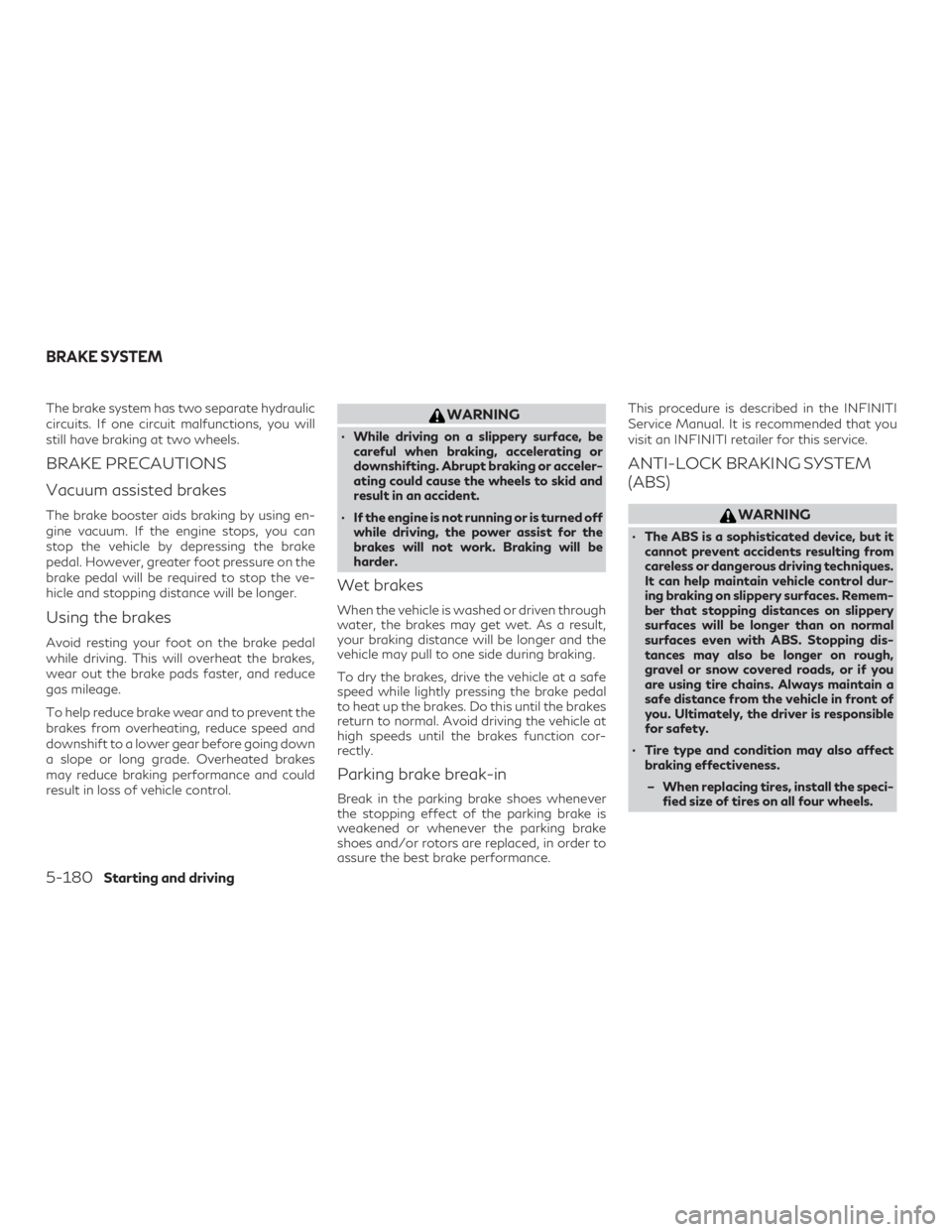
The brake system has two separate hydraulic
circuits. If one circuit malfunctions, you will
still have braking at two wheels.
BRAKE PRECAUTIONS
Vacuum assisted brakes
The brake booster aids braking by using en-
gine vacuum. If the engine stops, you can
stop the vehicle by depressing the brake
pedal. However, greater foot pressure on the
brake pedal will be required to stop the ve-
hicle and stopping distance will be longer.
Using the brakes
Avoid resting your foot on the brake pedal
while driving. This will overheat the brakes,
wear out the brake pads faster, and reduce
gas mileage.
To help reduce brake wear and to prevent the
brakes from overheating, reduce speed and
downshift to a lower gear before going down
a slope or long grade. Overheated brakes
may reduce braking performance and could
result in loss of vehicle control.
WARNING
∙ While driving on a slippery surface, becareful when braking, accelerating or
downshifting. Abrupt braking or acceler-
ating could cause the wheels to skid and
result in an accident.
∙ If the engine is not running or is turned off while driving, the power assist for the
brakes will not work. Braking will be
harder.
Wet brakes
When the vehicle is washed or driven through
water, the brakes may get wet. As a result,
your braking distance will be longer and the
vehicle may pull to one side during braking.
To dry the brakes, drive the vehicle at a safe
speed while lightly pressing the brake pedal
to heat up the brakes. Do this until the brakes
return to normal. Avoid driving the vehicle at
high speeds until the brakes function cor-
rectly.
Parking brake break-in
Break in the parking brake shoes whenever
the stopping effect of the parking brake is
weakened or whenever the parking brake
shoes and/or rotors are replaced, in order to
assure the best brake performance. This procedure is described in the INFINITI
Service Manual. It is recommended that you
visit an INFINITI retailer for this service.
ANTI-LOCK BRAKING SYSTEM
(ABS)
WARNING
∙ The ABS is a sophisticated device, but it
cannot prevent accidents resulting from
careless or dangerous driving techniques.
It can help maintain vehicle control dur-
ing braking on slippery surfaces. Remem-
ber that stopping distances on slippery
surfaces will be longer than on normal
surfaces even with ABS. Stopping dis-
tances may also be longer on rough,
gravel or snow covered roads, or if you
are using tire chains. Always maintain a
safe distance from the vehicle in front of
you. Ultimately, the driver is responsible
for safety.
∙ Tire type and condition may also affect braking effectiveness.
– When replacing tires, install the speci- fied size of tires on all four wheels.
BRAKE SYSTEM
5-180Starting and driving
Page 443 of 580
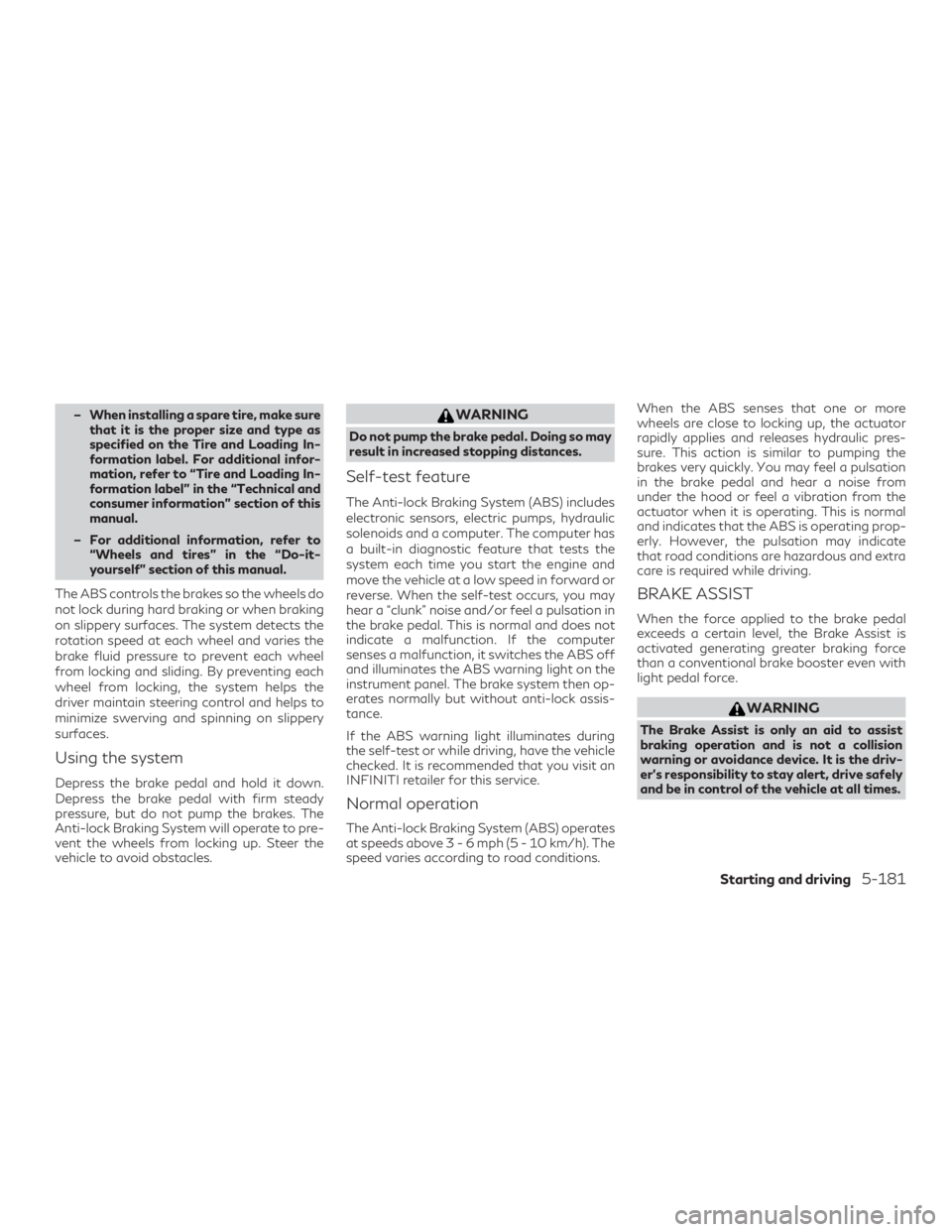
– When installing a spare tire, make surethat it is the proper size and type as
specified on the Tire and Loading In-
formation label. For additional infor-
mation, refer to “Tire and Loading In-
formation label” in the “Technical and
consumer information” section of this
manual.
– For additional information, refer to “Wheels and tires” in the “Do-it-
yourself” section of this manual.
The ABS controls the brakes so the wheels do
not lock during hard braking or when braking
on slippery surfaces. The system detects the
rotation speed at each wheel and varies the
brake fluid pressure to prevent each wheel
from locking and sliding. By preventing each
wheel from locking, the system helps the
driver maintain steering control and helps to
minimize swerving and spinning on slippery
surfaces.
Using the system
Depress the brake pedal and hold it down.
Depress the brake pedal with firm steady
pressure, but do not pump the brakes. The
Anti-lock Braking System will operate to pre-
vent the wheels from locking up. Steer the
vehicle to avoid obstacles.
WARNING
Do not pump the brake pedal. Doing so may
result in increased stopping distances.
Self-test feature
The Anti-lock Braking System (ABS) includes
electronic sensors, electric pumps, hydraulic
solenoids and a computer. The computer has
a built-in diagnostic feature that tests the
system each time you start the engine and
move the vehicle at a low speed in forward or
reverse. When the self-test occurs, you may
hear a “clunk” noise and/or feel a pulsation in
the brake pedal. This is normal and does not
indicate a malfunction. If the computer
senses a malfunction, it switches the ABS off
and illuminates the ABS warning light on the
instrument panel. The brake system then op-
erates normally but without anti-lock assis-
tance.
If the ABS warning light illuminates during
the self-test or while driving, have the vehicle
checked. It is recommended that you visit an
INFINITI retailer for this service.
Normal operation
The Anti-lock Braking System (ABS) operates
at speeds above3-6mph(5-10km/h). The
speed varies according to road conditions. When the ABS senses that one or more
wheels are close to locking up, the actuator
rapidly applies and releases hydraulic pres-
sure. This action is similar to pumping the
brakes very quickly. You may feel a pulsation
in the brake pedal and hear a noise from
under the hood or feel a vibration from the
actuator when it is operating. This is normal
and indicates that the ABS is operating prop-
erly. However, the pulsation may indicate
that road conditions are hazardous and extra
care is required while driving.
BRAKE ASSIST
When the force applied to the brake pedal
exceeds a certain level, the Brake Assist is
activated generating greater braking force
than a conventional brake booster even with
light pedal force.
WARNING
The Brake Assist is only an aid to assist
braking operation and is not a collision
warning or avoidance device. It is the driv-
er’s responsibility to stay alert, drive safely
and be in control of the vehicle at all times.
Starting and driving5-181
Page 445 of 580
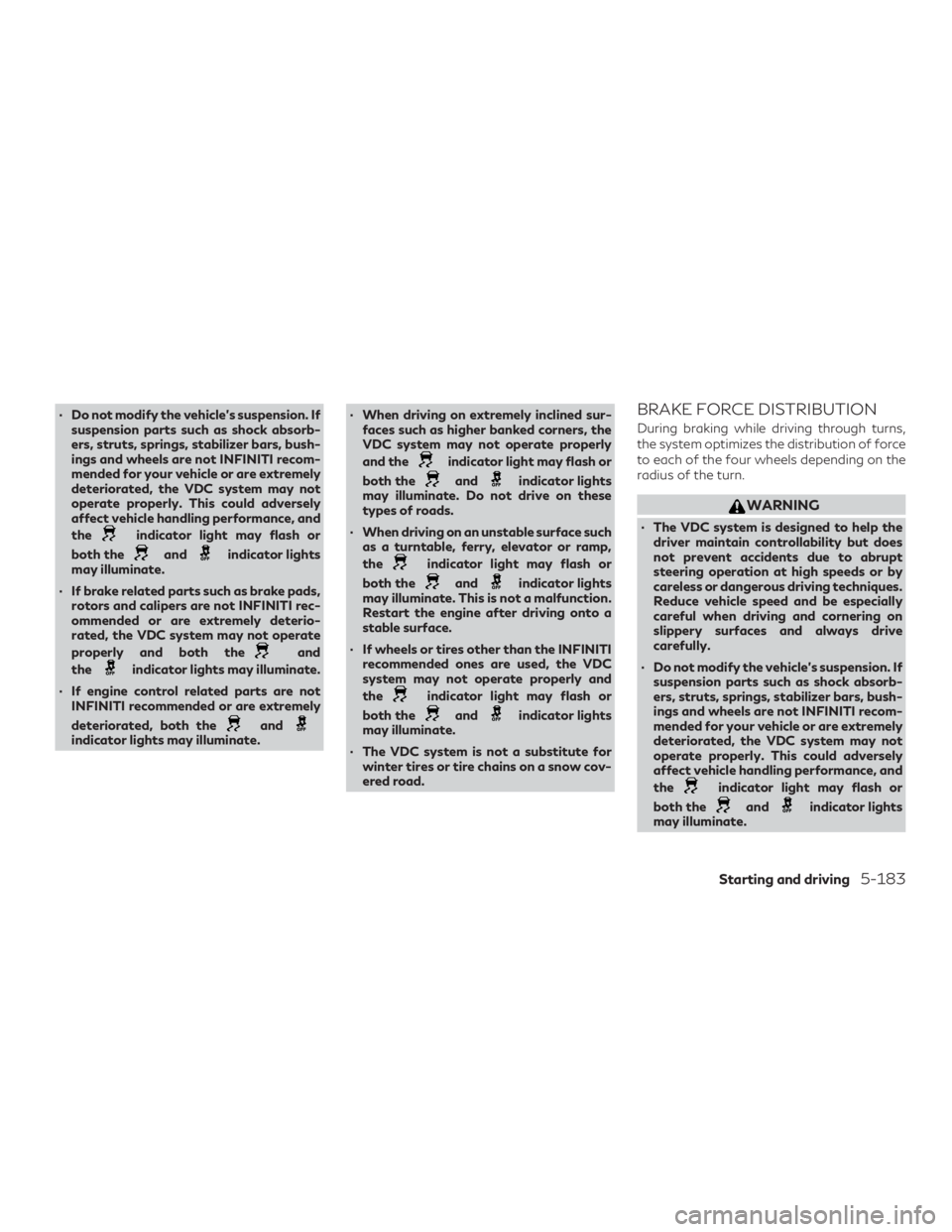
∙ Do not modify the vehicle’s suspension. Ifsuspension parts such as shock absorb-
ers, struts, springs, stabilizer bars, bush-
ings and wheels are not INFINITI recom-
mended for your vehicle or are extremely
deteriorated, the VDC system may not
operate properly. This could adversely
affect vehicle handling performance, and
the
indicator light may flash or
both the
andindicator lights
may illuminate.
∙ If brake related parts such as brake pads, rotors and calipers are not INFINITI rec-
ommended or are extremely deterio-
rated, the VDC system may not operate
properly and both the
and
the
indicator lights may illuminate.
∙ If engine control related parts are not INFINITI recommended or are extremely
deteriorated, both the
andindicator lights may illuminate. ∙ When driving on extremely inclined sur-
faces such as higher banked corners, the
VDC system may not operate properly
and the
indicator light may flash or
both the
andindicator lights
may illuminate. Do not drive on these
types of roads.
∙ When driving on an unstable surface such as a turntable, ferry, elevator or ramp,
the
indicator light may flash or
both the
andindicator lights
may illuminate. This is not a malfunction.
Restart the engine after driving onto a
stable surface.
∙ If wheels or tires other than the INFINITI recommended ones are used, the VDC
system may not operate properly and
the
indicator light may flash or
both the
andindicator lights
may illuminate.
∙ The VDC system is not a substitute for winter tires or tire chains on a snow cov-
ered road.
BRAKE FORCE DISTRIBUTION
During braking while driving through turns,
the system optimizes the distribution of force
to each of the four wheels depending on the
radius of the turn.
WARNING
∙ The VDC system is designed to help thedriver maintain controllability but does
not prevent accidents due to abrupt
steering operation at high speeds or by
careless or dangerous driving techniques.
Reduce vehicle speed and be especially
careful when driving and cornering on
slippery surfaces and always drive
carefully.
∙ Do not modify the vehicle’s suspension. If suspension parts such as shock absorb-
ers, struts, springs, stabilizer bars, bush-
ings and wheels are not INFINITI recom-
mended for your vehicle or are extremely
deteriorated, the VDC system may not
operate properly. This could adversely
affect vehicle handling performance, and
the
indicator light may flash or
both the
andindicator lights
may illuminate.
Starting and driving5-183